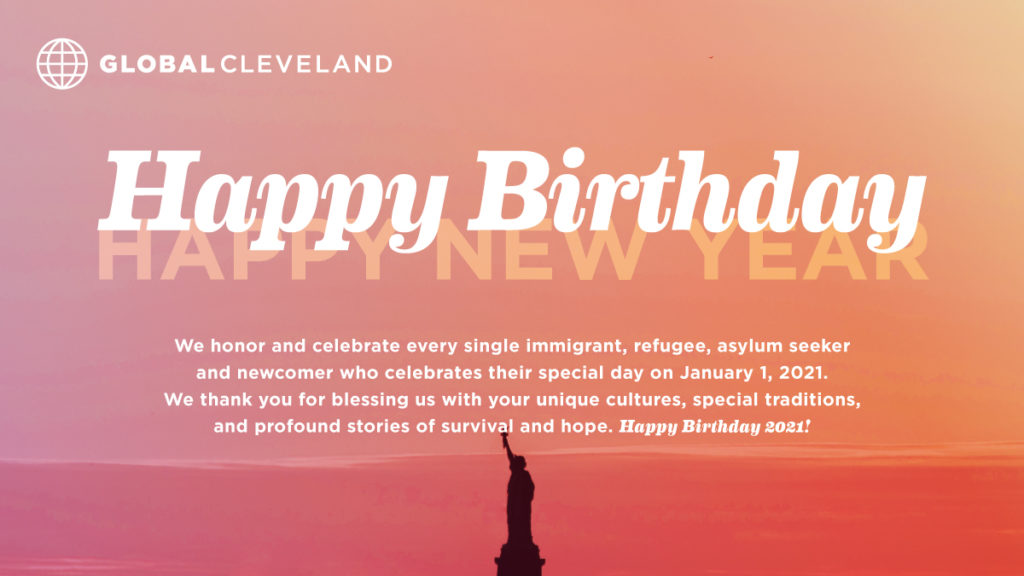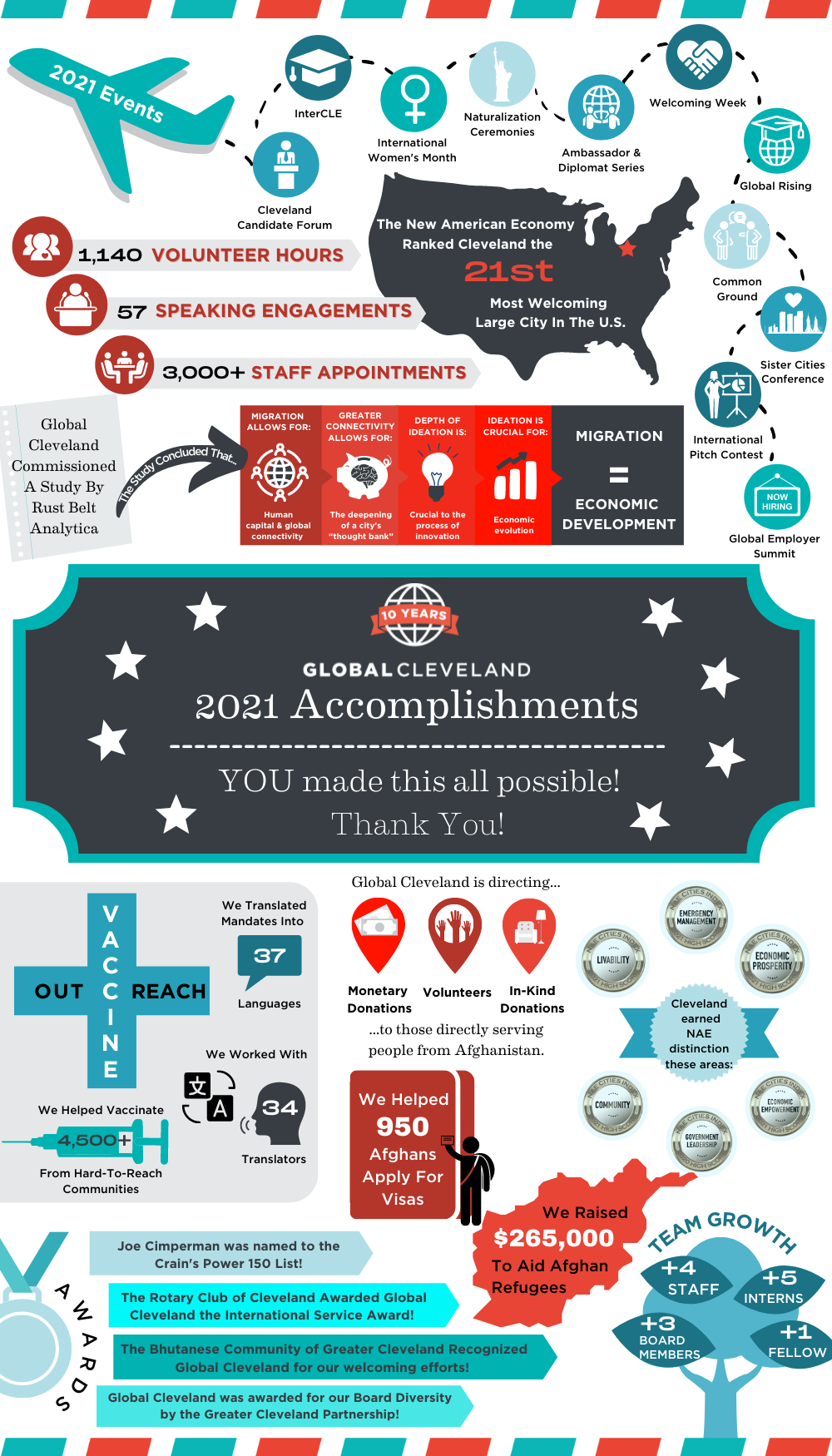A Conversation With Albina Ghazaryan
Migration is Economic Development

Executive Summary
The sponsor of this analysis, Global Cleveland, is an organization, but global Cleveland is also a reality. Elaborating, when it comes to the task of economic and community development, think of a city as a feather in the wind, or a stick in a rapid of water. Global forces push and pull at places, affecting a city’s relevance, or it’s standard of living. Yet some indicators are better measures of where a city fits into the global order of things than others. This analysis shows that standard measures of “success”, like population size, are relics of a bygone era where size mattered. In today’s idea economy, a better measure is gauging the quality of life in city, not the quantity of lives. This analysis looks at GDP per capita for the nation’s large metros, defined as “the amount of output or income per person in an economy…that’s indicative of average productivity or average living standards.[i]”
The GDP per capita in the Cleveland metro is currently $ 57,700 and ranks 78th out of 374 metros. This is up from an inflation-adjusted $51,320 in 2010. To the extent Cleveland can prepare for progress entails examining what explains progress. The analysis looked at what features are driving GDP per capita growth across America’s metros from 2010 to 2019. To do this, Rust Belt Analytica deployed a machine learning algorithm called permutation feature importance. This is our “Progress Model”. Out of hundreds of variables analyzed, two clusters of features dominated the model results: educational attainment and migration. That is, the rate of a metro’s GDP per capita growth could be predictively explained by the educational attainment of a region, and the migration rates of a region. Migration features included the in-migration of college- and non-college-educated foreign born, and the in-migration of college- and non-college-educated native born, particularly if the domestic migrants were arriving from the Northeastern or Western parts of the U.S. This latter migration pattern of coastal-to-inland migration has been dubbed “The Rise of the Rest”, characterized as the convergence of American tech labor from the costly coast into the American heartland.
It is a pattern of migration that highly-educated immigrants have in fact been doing for some time. The analysis found that the percent of Cleveland’s immigrants with an advanced degree was 21.4%, which ranked 8th out the nation’s largest 40 metros. Interestingly, 6 out of the top 10 most highly-educated cities for immigrants were in the geographic area of the Rust Belt, led by Pittsburgh.
The analysis finds that migration is crucial to the evolution of cities. Migration does not only allow for the accumulation of human capital, but for global connectivity as well. Connectivity is part and parcel with the act of migration, allowing for the deepening of a city’s “thought bank”. This depth of ideation is crucial to the process of innovation which, in turn, is crucial economic evolution. Put another way, migration is economic development. It is today. It was yesterday. And it will be tomorrow. The issue for Cleveland is whether the region can leverage its global assets to incur its global relevance, and ultimately the increased well-being of its people.
State Budgets’ Fair School Funding Plan Includes Important Provisions for English Learners
Global Cleveland is proud to see the Fair School Funding Plan included in the final draft version of HB110, the state budget for FY 2022-2023. The Fair School Funding Plan includes important provisions that will provide key funding to support English as a learning language Students here in Cleveland and throughout Ohio. These provisions include changes that make additional funding for English Learners proportional to the average cost to educate a student in Ohio. Previously, funding for English Learners was locked to set numbers provided in earlier spending bills. By making funding proportional to the rising cost of education, state lawmakers are ensuring that English Learners are not left behind. However, the most important change from these provisions is that the additional funding provided for English Learners must now be used to support English Learners’ education and cannot be redirected for other uses. This ensures that the funding is used for its intended purposes and the needs of our English Learners are not neglected.
Learning to understand and use English proficiently is key for Ohio’s immigrants and their children to obtain higher education, pursue successful careers, and participate fully in our communities. The above provisions more adequately provide for this important education, helping to ensure greater educational equity. We believe that these provisions will help lead to a better future for all Ohioans as it will help create a better prepared and better educated population. We are thankful that our state legislators see the value of our English Learners and hope to see more legislation beneficial to immigrant and international communities in the future.
Juneteenth 2021

At Global Cleveland, we are proud to commemorate Juneteenth. As an organization committed to a just society for all people, we must celebrate black and African American liberation while collectively thinking of ways to continue educating ourselves and working together to ensure a more diverse, equitable, and inclusive future.
Juneteenth, short for June Nineteenth, celebrates the emancipation of enslaved people in the United States of America. It falls on June 19th, when Union Soldiers and their commanding officer Major General Gordon Granger, arrived in Galveston, Texas, and informed those who had been enslaved that they were free. This occurring over two years after President Lincoln signed the Emancipation Proclamation.
Juneteenth, according to Juneteenth.com, is “the oldest nationally celebrated commemoration of the ending of slavery in the United States.” Despite not being recognized as a federal holiday, 47 states recognize Ohio among them. Fortunately, this year it looks as if this will finally change as the U.S. Senate has passed a bill to recognize the holiday, and the U.S. House of Representatives is moving to pass it. There is also a group of Ohio legislators attempting to make Juneteenth a paid state holiday.
Also, according to Juneteenth.com, “Juneteenth today celebrates African American freedom and achievement while encouraging continuous self-development and respect for all cultures.” As such, Juneteenth celebrations are celebrations of African American culture and history. They often include discussing the African American experience and readings, exhibitions, or performances of famous African American works. In addition, local communities oftentimes celebrate with parades, barbecues, or block parties, among other forms of celebration.
Below is a list of Juneteenth celebrations occurring in Greater Cleveland and Northeast Ohio. We want to encourage our colleagues, allies, and all of Cleveland and beyond to respect and affirm the dignity of African Americans by educating ourselves and celebrating the triumphs and achievements of African Americans.
Cleveland Juneteenth Events:
- June 19 & 20, join Djapo Cultural Arts Institute to celebrate culture, identity, and Juneteenth with a two-day workshop held at Inlet’s headquarters and a LIVE performance at the Rock & Roll Hall of Fame – Register HERE
-
Cleveland’s Freedom Fest is set to become an annual destination event in the heart of Downtown Cleveland, poised to position our community as a national leader in celebrating Juneteenth.
Set to take place on Saturday, June 19 from 12:00 pm – 10:00 pm on Mall C in the heart of Downtown Cleveland, the city-wide, family-friendly celebration and commemoration of Juneteenth will feature headline performances from by GRAMMY Award-winning performers Terri Lyne Carrington + Social Science with special guests Ms. Lisa Fischer and Maimouna “Mumu Fresh” Youssef; “Freedom on Juneteenth: Songs of Liberation,” a mainstage performance by Karamu House, the country’s oldest Black producing theatre; and a fireworks finale made possible by #CL3Alliance, the Cleveland Cavaliers, Cleveland Browns, and Cleveland Indians. See Schedule HERE
- Join Coventry Village and Safer Heights in supporting black-owned businesses and artists at our Juneteenth celebration on June 19th! Led by local black artists/organizers, this event is for our WHOLE neighborhood to celebrate the freedom and contributions of the black community in Cleveland Heights and beyond! More info HERE.
- Mx. Juneteenth: A Black & Queer Liberation Celebration. A free event with a suggested donation of $5; $10 for non-Black attendees. No one will be turned away for inability to pay. More info HERE. RSVP
-
Juneteenth: Party With a Purpose! Hosted by: Sevynteenth Foundation. The money raised from this event will go directly to fund scholarships for our summer campers! Tickets HERE
- #JuneteenthOnBuckeye: The Buckeye Summer Soul Series in partnership with NAACP Cleveland Branch, Black Lives Matter Cleveland and New Era Cleveland, will host the 4th Annual #JuneteenthOnBuckeye, Saturday, June 19, 2021, 12:00 PM – 6:00 PM, at the Art & Soul park located at 11802 Buckeye Rd, Cleveland, OH 44120. The celebration will include live entertainment, giveaways, food, vendors and various support resources for residents. More info HERE
- Land Before Rhyme – Juneteenth Show. Location: Unitarian Universalist Congregation of Cleveland 2728 Lancashire Road Cleveland, OH 44106 “On this day we will honor our ancestors with our truths, our stories, our hopes, our tragedies and triumphs with the spoken word. Don’t miss it” For tickets click HERE
- Juneteenth Bicycle Ride Around the Circle: Celebrate Juneteenth 2021 with Juneteenth Freedom Rides for a casual family-friendly bicycle ride through the University Circle area. Register HERE
- Juneteenth Unityfest: is a national Livestream event conceived by Grammy-nominated African-American artist Robert Randolph, that will bring together people of all backgrounds in a day of unity to commemorate and celebrate Juneteenth and Black culture with musical performances, inspiring remarks, films, comedy, storytelling, and appearances by civic leaders and influencers. SATURDAY, JUNE 19, 2021 5PM ET / 2PM PT. More info HERE
- Interconnected Liberation: Art and Conversation on Juneteenth and World Refugee Day; People’s Park 760-762 Elma Street Akron, Ohio 44302
- Deep Roots and BLM Cleveland Juneteenth Art Show. Friday, 9:00 PM – 1:00 AM: 3100 E 45th St #320
“Juneteenth is the celebration of freedom of the most southern slaves from the clutches of an institution of bondage. The artwork explores the many emotions around this perceived freedom and the journey to it.”
-
Juneteenth Block Party & Vendor Fair – UnBAR Cafe, 12635 Larchmere Blvd, Cleveland OH, 44120 12 PM-4 PM
-
Celebrate Juneteenth at GlenVillage Pavilion – GlenVillage, 1400 E. 105th St, Cleveland OH, 44106 5:30PM-8PM (June 18th)
-
Juneteenth Cleveland Cultural Gardens Centennial Peace Plaza, Harrison Dillard Trail, Cleveland OH, 44108 11AM-3PM
Global Cleveland stand in solidarity and support to AAPI (and all forms) Racism and Discrimination
“Global Cleveland stands united against racism and hate against our Asian American Pacific Islander community. The horrific surge in violence and hate-crimes that is happening across our country is unacceptable, and we must work to continue to stand in solidarity with our AAPI brothers and sisters. We condemn all forms of hate and are committed to rectifying racial inequalities in our society.
Our hearts go out to the reported shootings of Asian American women on Tuesday in Atlanta, for the victims' families, other victims of the hate crimes throughout the country, and the entire AAPI community. As a society, we must undergo a revolution of values to understand these communities' struggle, heritage, and contribution to the nation and its culture We need to choose solidarity over division and resistance over complicity as we keep building a future that works for everyone.”
Happy New Year, Happy Birthday. - By Nathanie Y. Yaskey

- By Nathanie Y. Yaskey
We are all waiting for the New York City Times Square ball drop, especially this year. To put one of the most challenging years in history to bed and with just 20 days before a more welcoming administration, we look for a year more compassionate for our immigrants, asylum seekers, and refugees. Other than your birthday, New Year’s Day is one of the most celebrated days of the year.
According to Business Insider, a sampling of immigration data shows that over 11,000 of the nearly 80,000 people admitted into the USA list January 1st as their birthday. This is especially so with our Somalian and Ethiopian sisters and brothers. So why is this? The answer is both simple and complex, depending on whose story it is. The main reason is that these refugees fled from nations that honor birth dates differently than we do. As they fled their homes with their families, leaving everything they knew in search of freedom and acceptance in a foreign land, important documentation was left behind as well. Often access to government documentation regarding birthdays is not always easy to find.
When these refugees come to the United States seeking asylum, they are often advised to list January 1st as their date of birth, as they have no formal birth records. Marilu Cabrera, a spokeswoman for U.S. Citizenship and Immigration Services notes, "[for those cases] the January 1 birth date is the common birth date that we assign." Among newcomers, the January 1st birthday is so common that at the stroke of midnight, along with Happy New Year, immigrant children also wish their parents Happy Birthday.
We honor and celebrate every single immigrant, refugee, asylum seeker, and newcomer who celebrates their special day on January 1, 2021. We thank you for blessing us with your unique cultures, special traditions, and profound stories of survival and hope. Happy Birthday 2021!
Fier and Cleveland - By Ezra Ellenbogen
Fier and Cleveland
- Written by Ezra Ellenbogen
Fier, Albania is a beautiful city of nature and history, with a population of 56,297.[1] The city is a well known travel destination, its most attractive landmark being the ruins of the ancient Illyrian city of Apollonia.[2] In 2006, under the Honorable Mayor Frank G. Jackson, Fier was partnered as a sister city with Cleveland.[3]
The first large arrival of Albanian immigrants to Cleveland was in the 1890s, as a part of the larger influx of Italian immigration.[4] This group was known as the Arbëreshë; they were descendants of Albanians who had fled to Southern Italy to escape the Ottoman Empire. The second significant arrival of Albanian peoples into Cleveland mostly originated from Korçë, an educational and cultural center in Southern Albania. The vast majority of this second wave were seeking new labor opportunities in Cleveland. Most had little to no former education or resources. Most were planning to immigrate temporarily, and most were men. They were seeking a better financial future. Eventually, many settled their families with them in Cleveland. These groups primarily concentrated on the West Side near Detroit Avenue and Linndale, though some did settle on the East Side around E. 30th and St. Clair.
Statewide, fewer than two thousand Albanians had settled by 1914. Most Albanian immigrants settled near Lake Erie. Most found work in factories or as day laborers. Albanian institutions followed suit; businesses sold traditional Albanian foods and products, and a total of three Albanian newspapers were created: Dielli, Liria, and Shqiptari i Lire.[5]By the start of the 1940s, approximately 1,000 Albanians resided in Cleveland.
The next major wave of Albanian immigration occurred Post-WWII. Numerous groups of Albanians had been displaced and had ended up in refugee camps in Italy, Germany, and Austria. From there, many immigrated to Cleveland. However, in 1946, when Enver Hoxha’s government took control of Albania, no Albanians were allowed to leave their home. New immigrants to Cleveland founded social clubs and religious institutions; in 1938, the Society of St. E. Premte was established by Orthodox Christain Albanians, which is still in use today.
During and post WWII, the major incentives for Albanian immigration were: escaping conflict back home, economic motives, and seeking to build a new life, as countless Albanian homes and businesses were destroyed in WWII and following conflicts. The highest concentrations in Cleveland remained on the West Side and its suburbs, particularly Lakewood.
The most significant influx of Albanian immigration to Cleveland came after 1992, when Albania’s political regime fell. Immigration from Albanian areas exploded, especially from Fier and Kosovo. Two major factors made Cleveland a well-sought home for this new wave of immigration. First: Albanian American Cleveland Councilwoman Dona Brady made significant and constant efforts to help Albanian refugees resettle. Second: during the 1999 war in Kosovo, the then American President Bill Clinton selected Cleveland as one of five cities to resettle refugees and displaced persons from the conflict. In 2006, The Honorable Mayor Frank G. Jackson founded a sister city relationship with the Albanian city of Fier in recognition of the flourishing community.
The Albanian American Association of Cleveland was founded in 1998. The organization went on to become one of the most prominent sources of organization and longevity for Cleveland’s Albanian community through cultural engagement, educational assistance, humanitarian aid, and supporting the community.[6] The most critical, long lasting, and well known engagement of the association and its partners was the creation of the Albanian Cultural Garden.
Spearheaded by immigration attorney and author Richard Herman, City Councilwoman Dona Brady, and Federation Of India Community Associations of NE Ohio (FICA) president Asim Datta, the process of creating an Albanian addition to the Cultural Gardens started on May 30th, 2012.[7] Cleveland architect Jim McKnight designed the Garden; its most prominent feature, a statue of Mother Teresa, was made by renowned Albanian artist Kreshnik Xhiku. The dedication ceremony was attended by important figures, including Mayor Frank G. Jackson and former Albanian President Bujar Nishani. The dedication was also a commemoration of the 100th anniversary of Albanian independence.[8]
The “Second Phase” of the Albanian Gardens was developed in 2013. It included a fountain from the 1920s rediscovered by Councilwoman Brady, walkways, and lights, making the area perfect for community events. The dedication of the new additions was attended by the then mayor of Fier, Baftjar Zeqaj, as well as a representative of the Albanian Prime Minister. In recent years, community events from operas to parades have been held at the Albanian Cultural Gardens. Most recently, during the Cultural Gardens’ 2019 One World Day Parade of Flags, Albanian Clevelanders wore traditional and cultural garb to celebrate their heritage, marching with Albanian flags (pictured at the start of the article).[9]
In 2014, Cleveland hosted highly acclaimed Albanian artist Fate Velaj and his exhibit, “Albania - Seen Differently.” Many of his works were on display in the Cleveland City Hall Rotunda. He hoped to reflect not only a new perspective of Albanian natural and architectural beauty, but also showcase the connection between Albanians and Cleveland.[10]
Albanian Clevelanders today make up a prominent and thriving community of the region. With numerous cultural and community-driven connections to Fier and Albania as a whole, Albanian Clevelanders have contributed to and embellished the city’s diversity and culture. Historic efforts of the sister city movement, from cultural showcases at fairs to operas, have connected the Albanian population of Greater Cleveland not only to Albania, but also establishing itself as a center for community and relationship building. Cleveland’s historic ties to Albania and Albanaian immigrants have made the community one of prominence and camaraderie.
- by Ezra Ellenbogen
Ezra's blog: One Page Stories
[1] https://www.worldometers.info/world-population/albania-population/
[2] https://www.intoalbania.com/city/fier/
[3] https://case.edu/ech/articles/cleveland-sister-city-partnerships
[4] https://case.edu/ech/articles/a/albanians
[5] http://ohiohistorycentral.org/w/Albanian_Ohioans
[6] http://albaniansofcleveland.org/index.php?p=home&op=more
[7] clevelandpeople.com/groups/albanian/albanian.htm
[8] https://www.clevelandculturalgardens.org/albanian-cultural-garden/
[9] http://www.clevelandpeople.com/events/2019/owd-2019-parade-3.htm
[10] https://www.youtube.com/watch?v=52FwyE5isXw
Klaipėda and Cleveland - Ezra Ellenbogen
Klaipėda and Cleveland
- Written by Ezra Ellenbogen
Klaipėda, Lithuania is a beautiful seaside town, located where the Curonian Lagoon empties into the Baltic Sea. The city is the most prominent point for international trade that goes through or into Lithuania, and is the only large sea port. The port can manage up to 40 million pounds of cargo annually.[1] The population of the Klaipėda is near 200,000.[2]Klaipėda’s history is interesting and intricate.
The 1250s were a memorable decade: the Seventh Crusade ended, Nichiren Buddhism got popular - good times. Also in the 1250s, Teutonic Knights established Klaipėda on an empty shore, calling it Memelburg.[3] The Teutonic Knights had been told to convert or destroy the local Pagan Baltic tribes, and chose modern day Klaipėda as a base. Originally, the area consisted of just a castle and a small town. In the 16th century, the local Teutonic Order secularized, and Memelburg became part of Prussia. It was then that the town started being called Klaipėda. Klaipėda was briefly Prussia’s capital during the Napoleonic wars, when the royal family retreated there. The 19th century brought thousands of new people to Klaipėda. In 1854, a devastating fire burned down two-thirds of the city, but it was rebuilt.
By around 1871, the first Lithuanians had immigrated to Cleveland. Early Lithuanian immigrants in the city concentrated around St. Clair and Oregon Avenue (which is now Rockwell Avenue).[4] The early Lithuanian community in Cleveland established the St. George’s Lithuanian Church, which became the center of activity for the predominantly Catholic community. Around that time, only around 1,000 Lithuanians lived in Cleveland.
Back home in Lithuania, the entire Klaipėda region had been absorbed into the Entente States from Germany. The region was ruled by the League of Nations until the Lithuanian supported Klaipėda Revolt of 1923. It was successful, and the League of Nations and the Entente states recognized the transfer of the Klaipėda region into Lithuania as an autonomous incorporation. At this time, Klaipėda was home to 45,000 people, 70% of whom were German.
By 1930, back in Cleveland, the Lithuanian population had grown to over 10,000 people. Cultural and religious centers, newspapers, and communities were being formed. A major reason for the spark in Lithuanian immigration to the US was the rise of political tensions at home.
The rise of Nazism in the 1930s spread into Klaipėda, but not without strong resistance. Germany sought to annex Klaipėda, despite being former allies. Lithuania was unable to gain major support to keep Klaipėda and gave in to the ultimatum, ceding it to Nazi Germany.
Nearing the end of World War II, Klaipėda was overrun by Soviet armies. At one point, the invading forces only found 20 inhabitants left, the rest having immigrated or died. The city was captured and incorporated into the Lithuanian Soviet Socialist Republic. Through the 1940s and 1950s, primarily Russians and Lithuanians repopulated the city. Klaipėda’s population skyrocketed; even just by 1950 it had grown larger than pre-war years. The region of Klaipėda soon became a major economic driver for Lithuania.
Post-World War II in Cleveland, there was a major influx in Lithuanian immigrants. Approximately 4,000 Lithuanians arrived in Cleveland, among them was Antanas Smetona, a former president of the Lithuanian Republic. Institutions established by these new immigrants tended to be distinct from those established by the first wave; as they mostly sought to renew or recreate organizations that had been banned or had collapsed in Soviet Lithuania.
Numerous organizations organized Lithuanians in Cleveland around culture, politics, language, and more. For instance, the Lithuanian-American Council lobbied during and after the war to bring attention to the troubles of the Lithuanian state under Soviet rule. Local organizations were also quick to organize around teaching culture and language. In 1973, a new community center, Lithuanian Village, was built along E. 185th St, and community activity shifted towards there and eastern suburbs.
During the re-establishment of an independent Lithuanian state, Cleveland was recognized for the Lithuanian community’s significant role in lobbying for liberation. The leader of the new state, Vytautas Landsbergis, visited Cleveland multiple times seeking support from local groups. When the US recognized the new Lithuanian state, the new US ambassador to it, Darryl N. Johnson, made his first visit as ambassador to Cleveland.
In 1992, under Mayor Michael R. White, an official sister city relationship between Klaipėda and Cleveland was formed.[5] In the modern day, Lithuanian-Americans in Cleveland interact frequently with their home state, with the establishment of business ties and assistance.The population of Lithuanian-Americans in the city numbers around 16,000.
The relationship and its history has been critical to both sides. Cleveland gained huge cultural and economic boosts from waves of Lithuanian immigrants, and, in the modern day, the city has helped Klaipėda with medical services and facilities, seeking to help improve the conditions of their sister city. Under the Hope Medical Mission, Cleveland nurses and doctors, in an effort founded by Dr. Gerald Goldberg, have worked directly with Lithuanian medical offices and workers to make medical treatment more accessible and better quality.[6] Not only that, but the group has worked to directly treat local patients and improve the quality of equipment available
Altogether, Cleveland and Klaipėda have had a long history of working together. Cleveland helped serve as a large base for lobbying against Lithuanian oppression, and works today on spreading culture and improving medical facilities in Klaipėda. Klaipėda and Lithuanian Americans in Cleveland have contributed greatly to work, culture, and community formation in the city. Despite being thousands of miles apart, Klaipėda and Cleveland have managed to both be critical to each other’s history.
- By Ezra Ellenbogen
Ezra's Blog - One Page Stories
[1] http://www.cleveland-oh.gov/CityofCleveland/Home/Government/MayorsOffice/Office_of_Government_Affairs/SisterCities#klaipeda
[2] https://worldpopulationreview.com/countries/lithuania-population
[3] http://www.truelithuania.com/history-of-klaipeda-memel-447
[4] https://case.edu/ech/articles/l/lithuanians
[5] https://case.edu/ech/articles/cleveland-sister-city-partnerships
[6] https://www.clevelandjewishnews.com/archives/rx-for-transforming-lives-of-lithuanians/article_c5fc93ae-0ef5-5149-a2a8-54a493d355fd.html
How to be an Emotional Ally to the Immigrant Community - By Nathanie Y. Yaskey
How to be an Emotional Ally to the Immigrant Community
- Written By Nathanie Y. Yaskey
When I first heard the statement, “we are living in unprecedented times,” I chuckled. The word “unprecedented” is so grandiose within itself that it reflexively induces a cringy feeling of melodrama.
I write comedy, I tell jokes on stage, I prefer to keep things light whenever and wherever possible. This was my attitude going into quarantine. I (like many others) thought the world was just being melodramatic and as soon as we got over this “flu,” Oprah would finally run for president, Cardi B would be her trusted Vice President, Beyoncé would be Secretary of State, and our new national anthem would be “Who Run the World? Girls!” … SPOILER ALERT: things didn’t exactly turn out that way.
Now, over six months into quarantine, I shudder to think that I ever remotely found entertainment in the current state of affairs. As social unrest grows louder, as violence catapults at an alarming rate, as extremist groups are birthed from pain and frustration, as othered bodies are slayed and politicized, as society increasingly places more value upon property than humanity, as life as we know it shatters upon the golden chandelier fan of America, all I can say is; “Um. Yeah. We’re definitely living in unprecedented times.”
As an African immigrant and naturalized Black citizen, I have experienced a range of emotions throughout my quest to naturalization, but nothing as sharp and soul-piercing as what quarantine has forced me (and so many other immigrants) to reckon with: fear.
We see ourselves unfairly generalized in print, we see our parent’s sacrifices dismissed, we see our pain spectacled. These experiences reduce us to a state of sheer fear and panic.
If you are looking for ways to support and peacefully embolden the immigrant community—even whilst safely distancing— please continue reading.
- More than anything else, we want to be heard. The acknowledgement of our humanity and right to occupy space can be as simple as asking, “How are you feeling?” And genuinely listening to our response.
- Silence speaks. If you don’t know what to say, that’s okay! Few things are more upsetting than describing a personal experience to someone from another cultural background who then morphs said experience into a particular language, code, or context that they are more comfortable with addressing. For instance, the time my Dad was publicly demeaned for having an accent is not the same as the time your Dad was publicly demeaned for incorrect grammar; I’m sure that both were scaring and painful in their own way, but reframing and comparing trauma is a dangerous game for all involved parties.
- Dialogue, not monologue. Talk to us, not at Over the years, I’ve come to realize one universal truth: dialogue empathizes, monologue sympathizes. Sympathy rarely does much good.
- Accentism. Guess what, folks?! It’s real! It’s discriminatory and it is not going anywhere until its damaging effects are properly addressed. My father is the smartest man I know, yet when he makes phone calls in America, I speak on his behalf. Not because he’s not fluent in English (he’s actually fluent in four languages), rather, the level of respect that he is treated with drastically changes when a stranger associates his accent with mutism. If you see this being done in public, call it out. It has been my experience that most people don’t even realize that their tone is inappropriate until they are confronted about it. Remember, ignorance does not equate maleficence.
- Speak out and speak up, but do not speak for These days, wars are waged on social media left and right. Interestingly enough, I often see people lending voice to the suffering of a group that they have no cultural ties to. Empathy is great, but self-righteous indignation on behalf of a marginalized group is, at its very root, based in colonialism and inherent disrespect. When you speak for me, you are unilaterally telling me that you can do a better job of evoking my own feelings; you are insinuating that you have a stronger voice than I do. Now, if you decide to respond to an offensive post on your own behalf, that’s great! Believe it or not, you can acknowledge your lack of first-hand experience whilst still making your point. For instance, a 28-year-old Black woman who is a naturalized American citizen, I would never try to speak on behalf of all 80-year-old Caucasian women who were born and raised in Australia. That’s to say, when discussing something that is beyond the scope of my lived experience, I provide my point of view strictly as someone outside of the demographic of which that issue directly impacts.
- Understand that we experience historic events differently, and that’s okay. I still remember the day of the 9/11 Terrorist Attacks. I vividly remember my fifth-grade teacher, Mrs. Pope, wheeling in a television into the classroom and keeping the channel on CNN; she casually ate a sandwich as we watched graphic footage of people jumping from what seemed to be the height of the sky. In the coming days, I saw the nation come together in a way that I had never seen before. At the time, my family and I did not yet have our green cards as we were still under Political Asylum. I remember overhearing teachers and other adults talk about immigrants and the need for stricter immigrant policies. I remember feeling, in the pit of my stomach, intense fear that my family and I would be forced to return to Sierra Leone, where we would most certainly have been persecuted. As the weeks passed, galvanized patriotism morphed into threatening language and threatening language ultimately erupted into hateful xenophobia. My mother was so scared for our safety, that she rushed out and bought “Proud to be an American” t-shirts for my siblings and I (mine featured Scooby Doo standing in full salute before a very bright, beaded and sparkly American flag). My mom warned me not to tell people where I was from and to only speak when I was spoken to (my accent was still distinguishable at that point). I share this story to illustrate the importance of recognizing that our lived experiences are different; many Americans remember the immediate aftermath of 9/11 as a time of altruism, heroism, sacrifice, brotherhood and sisterhood … while, I remember those aspects, I also experienced penetrating fear that was distinctive to being a new immigrant to the United States.
- I will end where I began; listen. Even within our silence, we are screaming to be heard. We are not complicit nor complacent and we are every bit as human as you and your loved ones. Sometimes the strongest support that you can offer is an open-mind and a conscientious ear that does not impose the need to direct, change, or adapt our language.
Yes, we are living in “unprecedented times, and unprecedented times call for unprecedented actions. Unprecedented actions yield unprecedented results. If my 28-years of life has taught me anything, it has taught me that humanity —at its very core— is inherently good. Americans are strong, adaptable, and more often than not, willing to listen to that which defies everything that they have known to be true through their own lived experience.
When I attend peaceful protests, I see people of every race and creed beside me. When I march for gender equality, I see men steadily matching my pace and chanting in unity. When I disagree with others, I see them willing to listen and grapple with foreign concepts that they once considered beyond their comprehension. When I see parents separated from their children, newcomers degraded on the national stage, I also see volunteers rushing to the streets in protest, lawyers spending days at a time in airports ready to offer pro-bono services to detainees, young people stepping away from computer screens and into the street because they understand that actions speak louder than words … I see resistance.
Today, stay calm, reach out to an immigrant and ask, “How are you feeling?”
Listen.
What’s there to lose? After all, only through unprecedented compassion can we bring about unprecedented change.
One Love.





